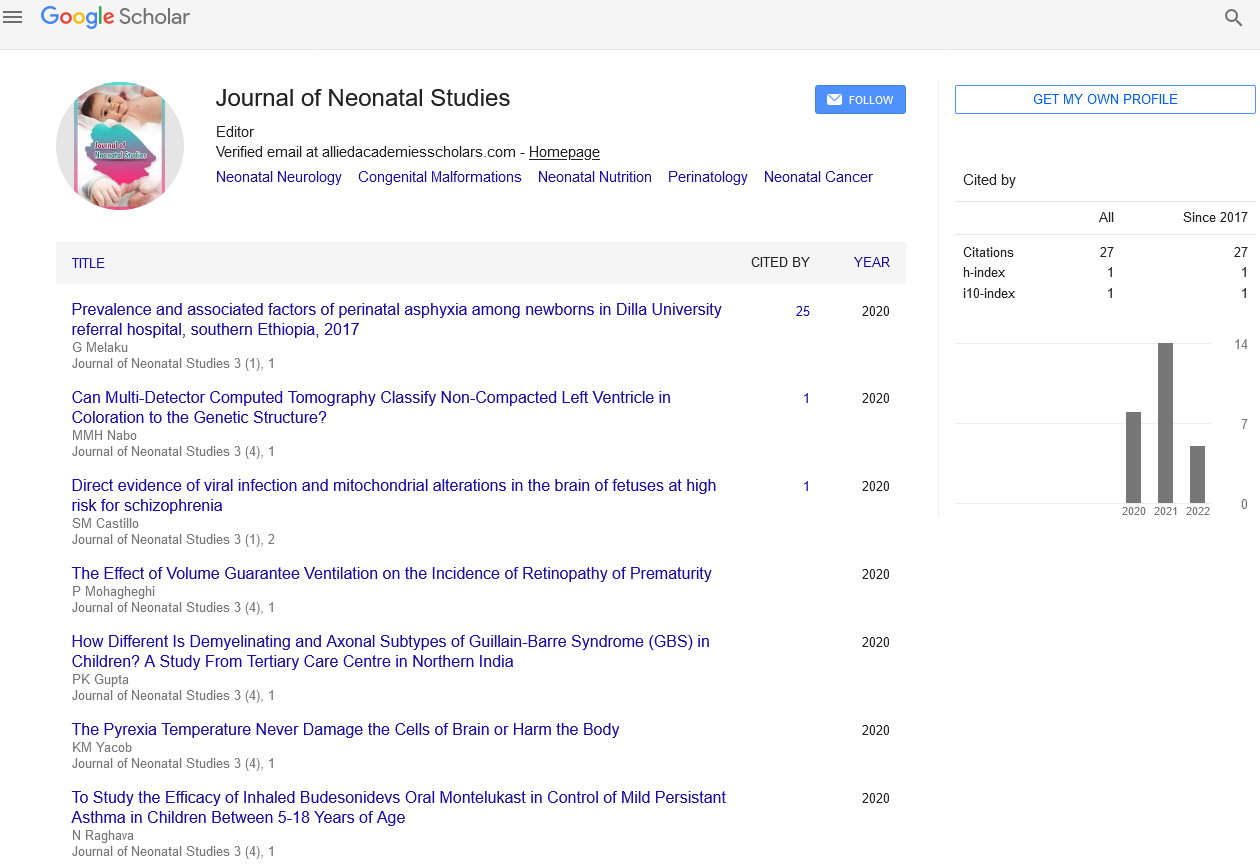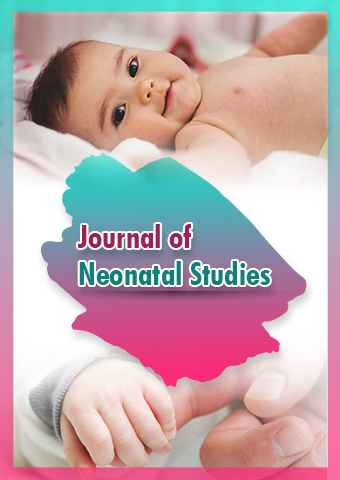Perspective - Journal of Neonatal Studies (2024) Volume 7, Issue 5
Extracorporeal Membrane Oxygenation (ECMO) in Neonates: A Lifesaving Technology
- Corresponding Author:
- Shigeru Osamu
Department of Neonatal Surgery, Dokkyo University School of Medicine, Japan
E-mail: shigeru.osamu030@dusm.edu
Received: 02-Sep-2024, Manuscript No. JNS-24-150535; Editor assigned: 04-Sep-2024, PreQC No. JNS-24-150535 (PQ); Reviewed: 18-Sep-2024, QC No. JNS-24-150535; Revised: 23-Oct-2024, Manuscript No. JNS-24-150535 (R); Published: 30-Oct-2024, DOI: 10.37532/JNS.2024.7(5).282-284
Introduction
Extracorporeal Membrane Oxygenation (ECMO) is a critical life-support technique used to support neonates with severe cardiac and respiratory failure. ECMO provides temporary support to the heart and lungs by oxygenating the blood outside the body, allowing these vital organs to rest and recover. This article delves into the principles, indications, procedure, management, and outcomes of ECMO in neonates, highlighting its significance in neonatal intensive care.
Description
Understanding ECMO
ECMO is a form of Extracorporeal Life Support (ECLS) that uses a machine to take over the function of the heart and lungs. The ECMO circuit consists of a pump to circulate the blood and an oxygenator (artificial lung) to add oxygen and remove carbon dioxide. The blood is returned to the patient’s body, bypassing the heart and lungs, which allows these organs to heal.
Indications for ECMO in neonates
ECMO is used in neonates with life-threatening conditions that do not respond to conventional treatments. Common indications include:
Severe respiratory failure: Conditions such as Meconium Aspiration Syndrome (MAS), Respiratory Distress Syndrome (RDS), and Persistent Pulmonary Hypertension of the Newborn (PPHN) can cause severe respiratory failure that may require ECMO support.
Congenital Diaphragmatic Hernia (CDH): Infants born with CDH have a defect in the diaphragm, leading to underdeveloped lungs and severe respiratory distress. ECMO can provide the necessary respiratory support while the infant undergoes surgical repair.
Sepsis and severe infections: Neonates with severe infections, such as sepsis, can develop multi-organ failure, including respiratory and cardiac failure. ECMO can support the infant’s organs while treating the underlying infection.
Cardiac conditions: Congenital heart defects, such as Hypoplastic Left Heart Syndrome (HLHS) and Transposition of the Great Arteries (TGA), may require ECMO support after surgery or during heart failure.
The ECMO procedure
The ECMO procedure involves several steps:
Patient selection: A multidisciplinary team assesses the neonate’s condition to determine if ECMO is appropriate. Criteria for ECMO candidacy include the severity of the condition, the likelihood of recovery, and the absence of contraindications such as severe intracranial hemorrhage.
Cannulation: Once the decision is made, the neonate is prepared for cannulation. Large cannulas (tubes) are inserted into the blood vessels, usually the jugular vein and carotid artery, to connect the ECMO circuit to the patient’s circulatory system. This procedure is typically performed in the operating room or at the bedside by a skilled surgeon or interventionalist.
Initiation of ECMO: After cannulation, the ECMO circuit is primed, and blood flow is initiated. The ECMO machine takes over the function of the heart and lungs, oxygenating the blood and removing carbon dioxide.
Monitoring and management: Continuous monitoring and management are essential to ensure the effectiveness of ECMO. Healthcare providers monitor vital signs, blood gases, and other parameters to adjust the ECMO settings and manage potential complications.
Types of ECMO
There are two main types of ECMO, each serving different purposes:
Veno-Arterial (VA) ECMO: VA ECMO provides both cardiac and respiratory support by diverting blood from a vein (usually the right atrium) and returning it to an artery (usually the carotid artery). This type of ECMO is used for neonates with severe cardiac failure or combined cardiac and respiratory failure.
Veno-Venous (VV) ECMO: VV ECMO provides respiratory support only by diverting blood from a vein (usually the right atrium) and returning it to another vein (usually the right atrium or superior vena cava). This type of ECMO is used for neonates with isolated respiratory failure who have adequate cardiac function.
Management and care of neonates on ECMO
Managing neonates on ECMO requires a multidisciplinary team, including neonatologists, ECMO specialists, nurses, respiratory therapists, and surgeons. Key aspects of care include:
Hemodynamic support: Ensuring stable blood pressure and adequate perfusion to vital organs. This may involve the use of inotropes and vasopressors to support cardiac function.
Ventilator management: While on ECMO, the ventilator settings are adjusted to “rest” settings to minimize lung injury. This allows the lungs to heal while the ECMO machine provides respiratory support.
Anticoagulation: To prevent clot formation in the ECMO circuit, anticoagulation therapy is administered, typically using heparin. Careful monitoring of coagulation parameters is essential to balance the risk of bleeding and clotting.
Nutritional support: Providing adequate nutrition to support growth and healing. Enteral feeding is preferred, but parenteral nutrition may be necessary if the neonate cannot tolerate enteral feeds.
Infection prevention: Implementing strict infection control measures to prevent nosocomial infections, as neonates on ECMO are at increased risk of infections.
Neurological monitoring: Regular neurological assessments and imaging studies to monitor for signs of intracranial hemorrhage or other neurological complications.
Complications of ECMO
Despite its lifesaving benefits, ECMO is associated with several potential complications:
Bleeding: Anticoagulation therapy increases the risk of bleeding, particularly intracranial hemorrhage, which can have severe consequences.
Infections: The presence of indwelling catheters and the critical condition of the neonate increase the risk of infections, including bloodstream infections and pneumonia.
Mechanical complications: Issues with the ECMO circuit, such as clots, air emboli, or equipment malfunction, can compromise the effectiveness of ECMO.
Neurological complications: Intracranial hemorrhage, ischemic stroke, and seizures are potential neurological complications associated with ECMO.
Outcomes and prognosis
The outcomes of neonates on ECMO vary depending on the underlying condition, the severity of illness, and the presence of complications. Advances in ECMO technology and neonatal care have improved survival rates, but long-term outcomes still vary.
Survival rates: Overall survival rates for neonates on ECMO are approximately 70-75%. Survival rates are higher for neonates with respiratory failure compared to those with cardiac failure.
Long-term outcomes: Many neonates who survive ECMO experience good long-term outcomes, but some may have ongoing health issues. Follow-up care is essential to monitor and address potential complications, such as developmental delays, neurological impairments, and chronic lung disease.
Case studies and success stories
Several case studies highlight the life-saving impact of ECMO in neonates:
Case study 1: A full-term infant with severe meconium aspiration syndrome was placed on VV ECMO due to refractory respiratory failure. After seven days of ECMO support, the infant’s lung function improved, and the baby was successfully weaned off ECMO. The infant was discharged home in good health, with normal developmental milestones.
Case study 2: A preterm infant born at 28 weeks’ gestation developed Persistent Pulmonary Hypertension of the Newborn (PPHN) and severe respiratory distress. The infant was placed on VA ECMO due to combined respiratory and cardiac failure. After 10 days of ECMO support and medical management, the infant showed significant improvement and was weaned off ECMO. The infant continued to thrive with no long-term complications.
Research and future directions
Ongoing research and technological advancements continue to improve the safety and efficacy of ECMO in neonates. Some areas of focus include:
Innovations in ECMO technology: Developing more efficient and safer ECMO circuits, including biocompatible materials and miniaturized devices for use in neonates.
Anticoagulation management: Investigating alternative anticoagulation strategies and monitoring techniques to reduce the risk of bleeding complications.
Neuroprotective strategies: Implementing neuroprotective measures to minimize the risk of neurological complications and improve long-term neurodevelopmental outcomes.
Individualized care: Tailoring ECMO management to the specific needs of each neonate, including personalized ventilation strategies, nutrition plans, and rehabilitation programs.
Conclusion
Extracorporeal Membrane Oxygenation (ECMO) is a critical and lifesaving technology for neonates with severe cardiac and respiratory failure. Through advanced medical technology and multidisciplinary care, ECMO provides the necessary support for these vulnerable infants to recover and thrive. Understanding the principles, indications, procedure, management, and outcomes of ECMO is essential for healthcare providers and families involved in the care of critically ill neonates. Ongoing research and innovation continue to enhance the safety and effectiveness of ECMO, offering hope for improved outcomes and quality of life for affected infants.

